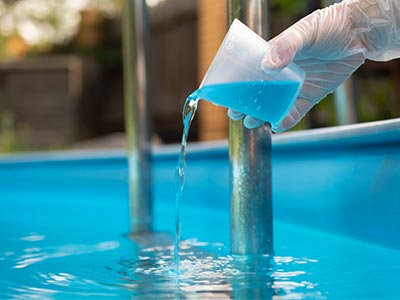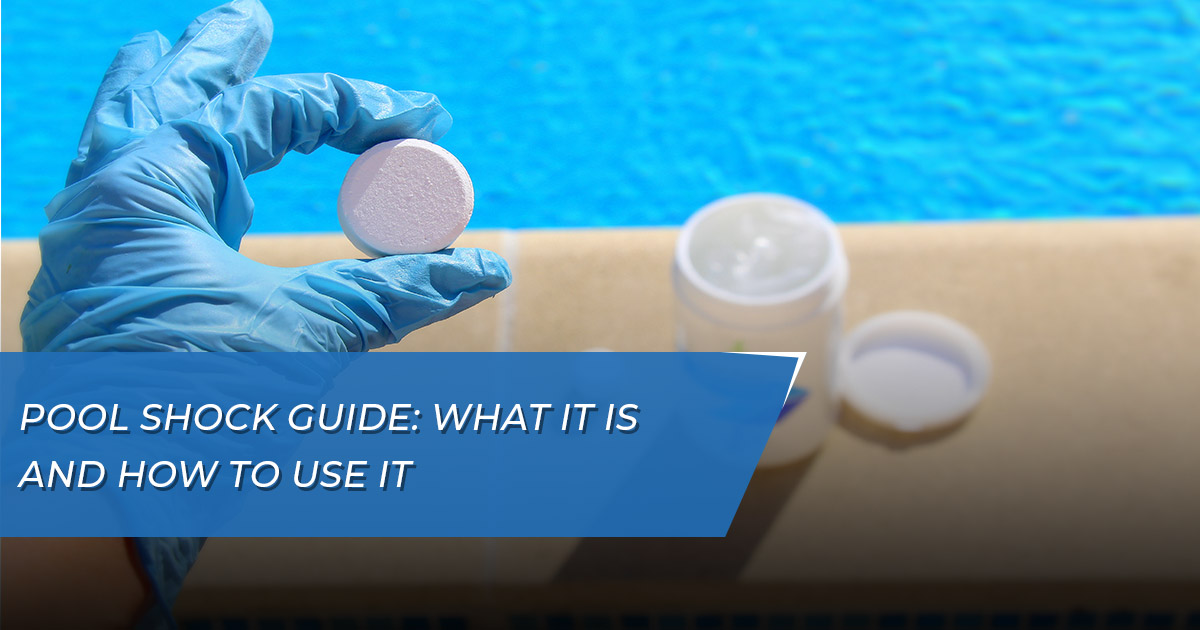Pool Shock Guide: What it is and How to Use it
Whether you currently own a swimming pool or are thinking of having one installed, you’ve likely heard the term “shocking” before. This word describes the process of adding specific types of chemicals to the water in order to make it as clean and swimmable as possible. In essence, pool shock gets the water to its best composition, which in turn allows chlorine and all of the other pool-cleaning chemicals to work properly.
Shocking a pool accomplishes a number of important things, all at the exact same time. In addition to creating an environment where your other pool chemicals can operate at peak efficiency, it quickly raises your water’s chlorine level. This helps break apart chloramines, which are otherwise known as combined chlorine. This in turn helps to kill algae, bacteria and any other harmful substances that may be present—leaving you and your guests with the clear, clean, and safe water that you deserve.
Pool shock may be necessary if you’re opening your pool for the year, or if you’re dealing with a situation where a lot of debris has built up over time. Regardless, it is an important task, and you need to follow a very precise process in order to get it right. Thankfully, doing so isn’t necessarily difficult, but it does require you to keep a few key things in mind.
The Differences Between Pool Shock & Chlorine
One of the most important things to understand about this process is that pool shock and chlorine are not technically the same thing and therefore should not be treated as such.
Chlorine is a chemical used to sanitize your pool water on a regular basis. It is integral to keeping your pool clear and healthy all year long. You periodically add chlorine to maintain the appropriate level (between 1.0 and 4.0 ppm), and your pool is ready for swimming. Chlorine can be added in a few different ways, including tabs that are inserted into your pool’s chlorinator and through flotation devices.
Pool shock is chlorine, but in very high doses. It is meant to “shock” your pool by raising the chlorine level incredibly quickly.
Although you will add regular chlorine far more frequently than you shock your water, both of these tasks are essential parts of maintaining a pool. If you don’t add pool shock, your chlorine level will likely not get where it needs to be in order to keep the water clean for long periods of time. If you’re not regularly adding chlorine to the pool already, the shock won’t be able to work as effectively when you perform it. Consider both of these concepts to be two sides of the exact same coin.
Some people recommend shocking your pool at least once every two weeks. During particularly hot periods or when your pool is seeing heavy use, you may have to do it more often. Likewise, the size of your pool will play a role in determining when you should shock it.
Shocking A Pool: Overview of When to do it
Shocking a pool is necessary for several common reasons. One of them involves “opening” your pool after having it closed for a period of time. In other parts of the country, people do this after winter as the weather begins to warm up. In Florida, this may be necessary if you’ve been away for a while and had your pool closed, or if you just haven’t used it in a few months.
Another situation when shocking a pool is necessary is if you have recently seen a lot of swimmers due to an event like a pool party. If you’ve invited a few friends and family members (or even a good chunk of the neighborhood) over to enjoy the weather, you’ll want to shock your pool to make sure that it is as sanitary as possible moving forward.
Other situations when you’ll need to shock your pool involve weather-related conditions. If the water has been constantly exposed to high temperatures and sunlight, or if you’ve gone through a period of particularly heavy rainfall, you’ll need to shock your pool to prevent the buildup of organic material that can lead to less than ideal conditions.
Finally, if you’ve just recently installed a new pool or if you’ve had any type of construction in or around your pool area, that likely means that you’ll be performing what is called a “fresh fill” of the pool itself. In that case, you’ll definitely want to shock your pool to make sure that your water is as clean as it can be before you jump in.
What Types of Pool Shock are Available?
There are three main types of pool shock available for you to choose from depending on your needs. They include powder shock treatments, liquid shock treatments, and tablet shock treatments.
Depending on what brand you choose, powder shock treatment either comes premixed or is added directly to your water. This is a common type of pool shock. Liquid pool shock is poured directly into your pool’s water, and it immediately disperses. The benefit here is that you don’t have to wait for anything to dissolve like you would with powder. This type of pool shock is also usually more cost-effective than the powdered variety.
Finally, there are tablet shock treatments. After you add the tablet to the pool, it often takes between one and two hours for it to dissolve. Then, it will take 24 to 48 hours for it to disperse throughout the pool and do its job.
Shocking a Pool: A Guide
 Begin the process of shocking a pool by first testing and balancing the water. Verify that the pH is between 7.2 and 7.6 ppm before you proceed. The total alkalinity should be between 80 and 120 ppm. If either metric is off, add the appropriate chemicals and test again until everything is where it should be.
Begin the process of shocking a pool by first testing and balancing the water. Verify that the pH is between 7.2 and 7.6 ppm before you proceed. The total alkalinity should be between 80 and 120 ppm. If either metric is off, add the appropriate chemicals and test again until everything is where it should be.
Next, you’ll want to take the proper safety precautions—the same way you would when working with any type of pool chemical. All types of pool shock products come with inherent risks, so it is key to be as safe as possible when using them. Don’t get them on your clothes or skin, for example. Always wear protective gloves and eye coverings to avoid any accidents or injuries during this process. Or, you can choose to call in the help of a professional to eliminate the chance that something could go wrong.
At this point, you’ll want to calculate the appropriate amount of pool shock to use based on the size of your pool. As a rule of thumb, you should use approximately one pound of shock for every 10,000 gallons of water. This should be straightforward, as most shock comes in bags that hold one pound. So all you have to do is calculate how many bags you need.
Having said that, different manufacturers may have slightly different requirements, so always consult the directions before you continue.
You may already know how many gallons of water your pool contains. If not, multiply the length by the width by the depth by 7.5. This calculation reveals the total number of gallons.
Next, you can make your shocking solution (if applicable). If you’re using a tablet pool shock, you will just add the tablets themselves to the water. If you’re using a powder shock, you need to fill a five-gallon bucket with water and then add one pound of shock. Stir the solution until the shock is fully dissolved. Repeat this process for however many pounds of shock you need to add.
Then, you can add the shock to the pool. If you’ve made a shock solution, walk around the outside of your pool and pour the water from your bucket slowly into the pool. This will allow it to circulate quickly thanks to your pool jets. If you’re using liquid, you can employ the same technique.
If any of your powder shock wasn’t dissolved and begins to build up at the water line of your pool, be sure to get your brush out and clean it quickly to avoid staining.
Keep your pool pump running for at least 24 hours to make sure the shocking process is complete. Note that you may have to shock a pool multiple times if it’s particularly large or contains more algae than usual.
Once you have completed this process, it’s critical to note that you shouldn’t just jump right back in the pool again. For the best results, wait at least 24 hours before you start swimming after the pool shock has been given ample time to work. Larger pools may require you to wait a bit longer.
If you enter the water too soon after you shock your pool, a few bad things could potentially happen. You will probably see your skin begin to dry out quickly because the chemicals react with the water in a way that produces acid. If you have a preexisting skin condition like psoriasis, this will almost certainly make it worse.
Likewise, the water can cause a painful sensation in both your eyes and lungs if you inhale it. You may experience blurred vision, for example, shortness of breath and even wheezing if you ingest any of the water. This is why you should always wait the appropriate amount of time before you begin to use your pool normally. Try to plan out your pool shock process well in advance so that everything is finished before any gatherings you may be having.
During this time, it would also be a good idea to test your pool water’s chemical levels to make sure that everything is where it should be. Be sure to test the water’s pH and chlorine levels to verify that they are in the appropriate range. Your chlorine level should be between 1.0 and 4.0 ppm (parts per million), while the pH level should always stay between 7.2 and 7.8 ppm. If not, add the right chemicals to the water to get things where they need to be. You should test your pool water again to make sure everything went well.
Need Help with Pool Maintenance?
For many years, people have seen GPS Pools as a trusted authority in the pool industry. Whether you’re shocking your pool for the first time, want more detailed answers to your questions or just need the chemicals so that you can complete the process yourself, you can always turn to our passionate and experienced team in your time of need. We also offer pool maintenance services that allow you to rest easy knowing that all of your pool shock and related tasks are fully taken care of.

